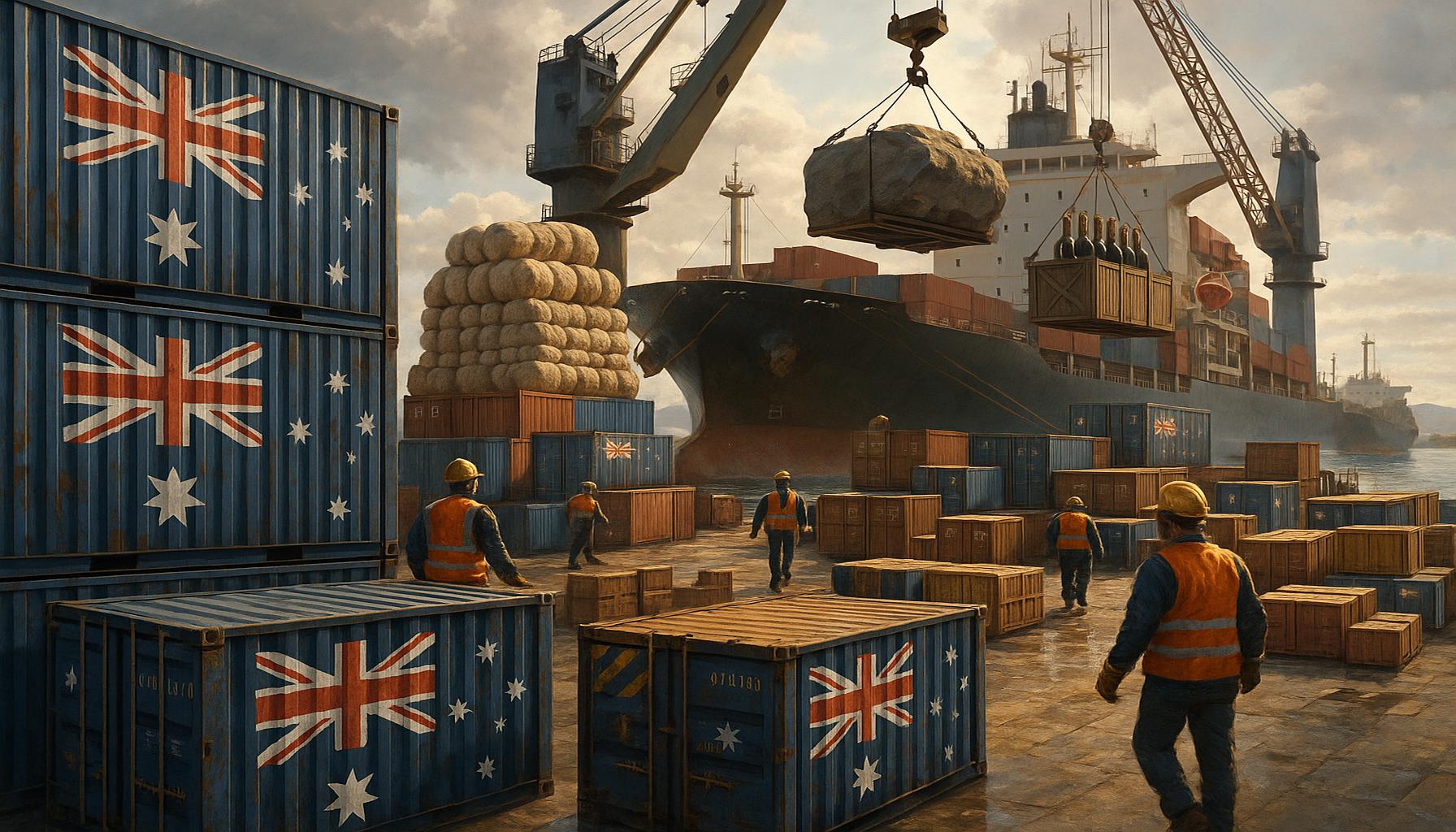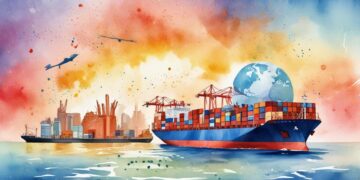The impact of trade tariffs on the competitiveness of Australian exports

Understanding Trade Tariffs in Australia
Trade tariffs are taxes imposed by governments on imported goods, and they can significantly influence the economic dynamics of nations, including Australia. These tariffs are not merely fiscal measures; they have far-reaching implications for export competitiveness, overall economic health, and industry viability. As Australia operates within a global market, the repercussions of tariff impositions or reductions are felt across various sectors.
Cost of Goods
One of the primary effects of trade tariffs is the increased cost of goods. When tariffs are levied on Australian exports, the final price that international buyers face rises. For instance, if Australia exports wine to the United States and a tariff is imposed, American distributors may choose to source from countries with lower or no tariffs like Chile or Argentina. This situation makes Australian wine less competitive, potentially reducing market share and revenue for local wineries that rely heavily on exports.
Market Access
Tariffs can also limit market access, which is essential for businesses looking to expand their reach. For example, if key trading partners like China or India increase tariffs on Australian agricultural products such as beef or dairy, Australian farmers might find it increasingly difficult to enter or sustain operations in these lucrative markets. The result can lead to stagnation, impacting job creation and local economies reliant on these industries.
Impact on Supply Chains
The complex web of supply chains in today’s global economy means that tariffs can disrupt established networks, significantly affecting production and distribution. For instance, Australian manufacturers who rely on imported components might face increased costs due to tariffs on their raw materials, which could lead to increased prices for consumers and reduced competitiveness. In response, businesses may need to reevaluate their sourcing strategies, possibly seeking alternative suppliers or even relocating parts of their operations to countries with more favorable trade conditions.
Sector-Specific Responses
The effect of tariffs is not uniform across all sectors; industries such as agriculture, mining, and manufacturing may experience differing levels of pressure from competition. In agriculture, for instance, the Department of Agriculture, Water and the Environment often analyzes the impact of tariffs on commodities. Tariffs on Australian iron ore, on the other hand, would primarily affect the mining sector, as companies contend with profitability margins influenced by global market fluctuations and demand.
Adapting to Change
Given the variability and complexity of trade tariffs, it is crucial for Australian stakeholders to monitor these shifts actively. By analyzing historical data and current tariff policies, businesses can develop strategies to maintain their competitive edge. For example, engaging with trade experts or utilizing government resources can provide insights into potential changes, allowing companies to prepare for new market conditions. Thus, being proactive rather than reactive can be a determining factor in sustaining and enhancing export competitiveness in an increasingly complex global trade environment.
CHECK OUT: Click here to explore more
Economic Implications of Trade Tariffs on Australian Exports
As Australia is intricately linked to global trade networks, the imposition of trade tariffs can create substantial economic ramifications. Trade tariffs not only alter the pricing structure of exported goods but also influence the broader economic climate. Understanding these implications is essential for business leaders, policymakers, and stakeholders in various sectors.
Price Elasticity of Demand
The price elasticity of demand plays a crucial role in determining how tariffs affect export competitiveness. Products that have a high price elasticity—such as luxury goods—are particularly vulnerable to tariff increases. For instance, if the price of Australian-made electronics increases due to tariffs, international consumers might opt for cheaper alternatives from competitor nations like South Korea or Japan. On the other hand, products with inelastic demand, such as essential commodities like pharmaceuticals, may not experience the same decline in sales despite tariff impositions. This variance necessitates an industry-specific approach to assessing the impact of tariffs.
Strategic Industry Adjustments
To mitigate the adverse effects of trade tariffs, Australian businesses often implement strategic adjustments. These may include:
- Cost Management: Companies may seek to enhance operational efficiencies to absorb increased costs caused by tariffs without passing them on to consumers.
- Product Differentiation: By emphasizing unique selling propositions, Australian businesses can create a brand value that mitigates the effects of price increases due to tariffs.
- Diversification of Markets: Exploring new markets or increasing presence in existing ones can reduce dependency on specific countries and lessen the impact of tariffs from any single partner.
Long-term Competitiveness
While short-term adjustments may help businesses adapt to immediate tariff impacts, long-term competitiveness relies on sustained innovation and investment. A failure to innovate could result in Australian exporters falling behind global competitors who are using lower production costs enhanced by favorable tariff conditions. Additionally, investment in research and development can facilitate the creation of superior products that can command premium pricing even amid tariff challenges.
Government Role in Mitigation
The Australian government has a crucial role to play in mitigating the effects of trade tariffs through various mechanisms, such as trade agreements and diplomatic negotiations. By pursuing favorable trade agreements that lower or eliminate tariffs with key trading partners, the government can provide Australian businesses with increased market access. Efforts to advocate for Australian industries on the global stage can also ensure that trade barriers are more equitable, enabling a fairer competitive environment.
In conclusion, the impact of trade tariffs on the competitiveness of Australian exports is multifaceted and requires careful consideration of various economic dynamics. Businesses must remain vigilant, adapting their strategies while policymakers work to create an environment conducive to free trade and competitive advantage.
SEE ALSO: Click here to read another article
Global Market Dynamics and Australian Export Competitiveness
The interconnectedness of global markets means that Australian exporters face competition not only from local enterprises but also from foreign manufacturers. Trade tariffs can reshape these dynamics, often favouring exporters from nations that are not subject to similar tariffs. Consequently, understanding the global market landscape is vital to grasping how tariffs impact Australian competitiveness.
Impact on Export Volume
One of the primary concerns when tariffs are imposed is the effect on export volume. When exporting nations increase tariffs on Australian goods, the immediate consequence may lead to a decrease in demand for these products. For instance, if China, a significant trading partner, raises tariffs on Australian agricultural products, such as wine and beef, it could negatively impact sales volumes. This decline not only affects immediate revenue but can also have long-term implications for market share and brand reputation. Exporters may struggle to retain customers who turn to alternative suppliers, and this loss may be particularly challenging for SMEs (small and medium enterprises) that lack the resources to sustain reduced sales.
Currency Fluctuations and Tariffs
The Australian dollar’s value against other currencies is frequently influenced by changes in trade policies and tariffs. A strong Australian dollar may compound the negative effects of tariffs, making Australian products more expensive abroad. Conversely, a weaker dollar could potentially offset tariff impacts for exporters, allowing for more competitive pricing. However, currency fluctuations can also lead to increased costs for imported raw materials, which can affect overall production costs. Thus, exporters must strategically manage foreign exchange risks alongside tariff considerations to maintain competitiveness in international markets.
Trade Diversion Effects
Trade tariffs can also give rise to trade diversion effects, where trade routes shift in response to changing tariff regimes. For example, if the United States imposes tariffs on certain Australian goods, it may encourage Australian exporters to seek markets in countries that maintain lower or no tariff barriers. In this scenario, countries like Indonesia or Singapore—who have established free trade agreements with Australia—become more attractive destinations. However, such shifts require that Australian businesses not only understand new markets but also adapt their marketing strategies and comply with different regulatory requirements, which can be resource-intensive.
Innovation and Product Development
In a competitive landscape impacted by tariffs, firms may be compelled to invest more in innovation and product development. By enhancing product quality or developing new features, companies can maintain a competitive edge even when facing elevated tariff rates. This is especially pertinent for industries such as technology and pharmaceuticals, where advancements can lead to higher consumer demand and justifiable price points. Investment in innovation is not solely a reactive measure to tariffs but a proactive strategy that ensures that Australian products maintain their appeal amidst changing global trade dynamics.
As Australia navigates the complexities of international trade, understanding the direct and indirect impacts of trade tariffs is essential for maintaining export competitiveness. Businesses must take a holistic approach, considering both the immediate effects of tariffs and the long-term strategies required for sustaining growth and market relevance.
CHECK OUT: Click here to explore more
Conclusion
In summary, the impact of trade tariffs on the competitiveness of Australian exports is multifaceted and significant. As we have explored, tariffs can lead to a decrease in export volumes, affecting both immediate revenue and long-term market presence, particularly for small and medium-sized enterprises. The fluctuations in the exchange rate further complicate this landscape; a strong Australian dollar may render our goods less competitive internationally, while a weaker dollar can introduce pressures on import costs.
Moreover, the trade diversion effects illustrate how tariffs can reshape trading relationships, prompting Australian exporters to seek alternative markets that perhaps offer more favourable conditions. This shift underscores the importance of market adaptability and strategic foresight in navigating international trade. Investments in innovation and product development emerge as essential strategies for maintaining competitive advantages, enabling exporters to meet changing consumer demands and justifying their pricing amidst tariff-induced challenges.
Ultimately, Australian businesses must adopt a comprehensive approach to address these tariffs and their ramifications. By leveraging innovation, understanding market dynamics, and strategically managing exchange rate risks, they can enhance their competitive positioning in the global marketplace. Continual assessment of trade policies and proactive market engagement will be crucial in ensuring the resilience and growth of Australian exports in the face of evolving trade environments.

Beatriz Johnson is a seasoned financial analyst and writer with a passion for simplifying the complexities of economics and finance. With over a decade of experience in the industry, she specializes in topics like personal finance, investment strategies, and global economic trends. Through her work, Beatriz empowers readers to make informed financial decisions and stay ahead in the ever-changing economic landscape.






